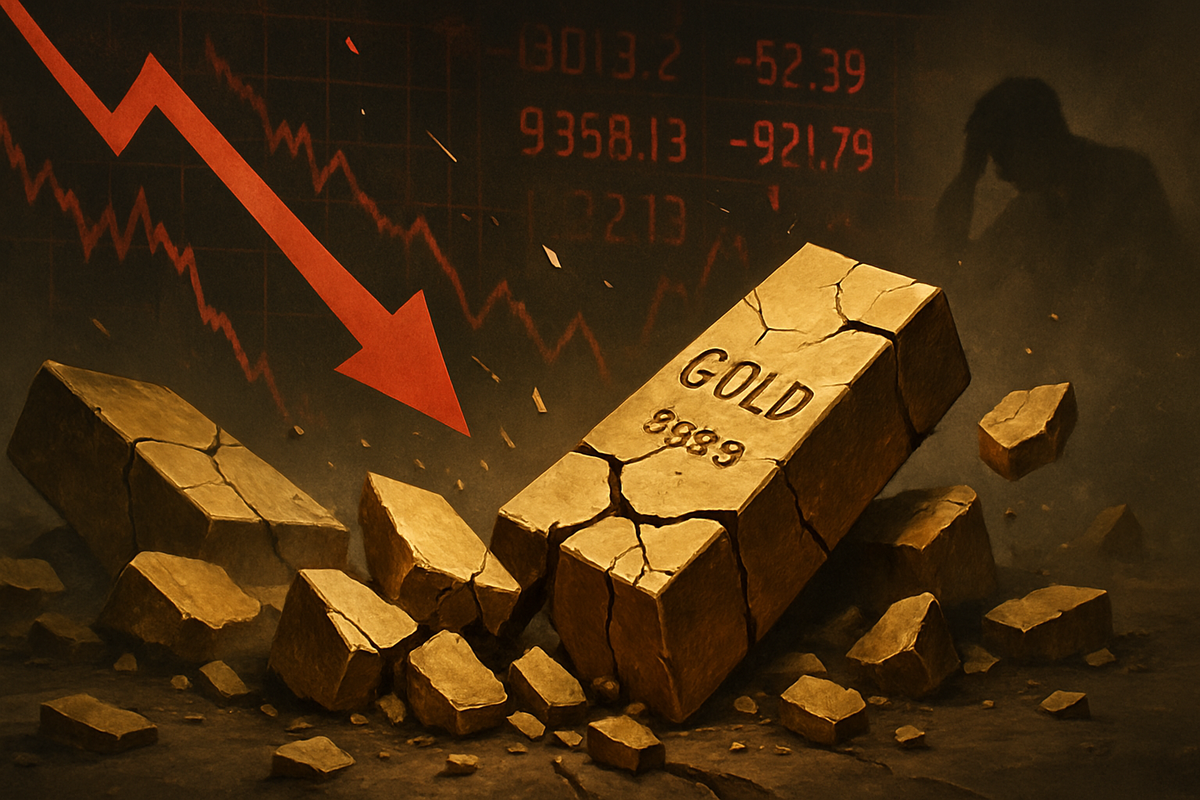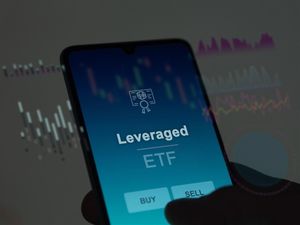Financial News
Gold Plummets from Record Highs: What's Next for the Yellow Metal?

The global financial markets are still reeling from a historic downturn in gold prices that occurred just days ago, in mid-October 2025. After an unprecedented rally that saw the precious metal shatter all previous records, gold experienced its most significant single-day collapse in over a decade, sending shockwaves through investor portfolios and sparking intense debate over its future trajectory.
This dramatic correction has left investors questioning the stability of the safe-haven asset and recalibrating their strategies. While the immediate aftermath has seen some stabilization, the sudden and sharp decline underscores the inherent volatility even in traditionally perceived secure investments, prompting a re-evaluation of market fundamentals and the broader economic landscape.
A Golden Bubble Bursts: The Anatomy of a Mid-October Crash
The "massive gold crash" unfolded rapidly in mid-October 2025, culminating in a dramatic sell-off on October 21st. Leading up to this event, gold had been on an extraordinary tear throughout the year, with some reports indicating a staggering 54-57% year-to-date gain by October. The metal had surged past the $3,000 per ounce mark in March and breached $4,000 in early October, reaching an all-time high of $4,530.00 per ounce on October 17, 2025, and another peak of $4,381 on October 21, 2025.
However, the very day it touched these dizzying heights, October 21, 2025, witnessed a breathtaking reversal. Gold plummeted more than 5% in a single trading session, with intraday drops as steep as 6.3%, bringing prices back near the $4,000 an ounce level. By October 22, prices had fallen below $4,100, and some Indian markets saw continued declines on October 23, 2025. This swift and brutal correction erased months of consistent gains within hours, leaving a trail of shaken investor confidence.
The immediate market reaction was characterized by widespread shock. The sell-off wasn't confined to gold; other precious metals also suffered significant plunges, with silver futures falling 6.7% and platinum futures dropping 7.2% on October 21st. Gold mining stocks and exchange-traded funds (ETFs) naturally followed suit, experiencing substantial losses. Analysts quickly moved to characterize the event as a much-needed "technical correction" after an unsustainable parabolic rally, driven by a confluence of factors including aggressive profit-taking, a strengthening U.S. dollar making gold more expensive for international buyers, easing geopolitical tensions that reduced its safe-haven appeal, and technically overbought market conditions amplified by algorithmic trading.
Corporate Fortunes in Flux: Winners and Losers from Gold's Volatility
The recent gold crash has inevitably created a ripple effect across various sectors, creating both challenges and unexpected opportunities for public companies. The most immediate impact is felt by gold mining companies and related investment vehicles.
Gold mining giants such as Barrick Gold (NYSE: GOLD) and Newmont Corporation (NYSE: NEM) are likely to see their share prices pressured in the short term. Their profitability is directly tied to the price of gold, and a significant drop in prices reduces revenue expectations and profit margins, especially for mines with higher operating costs. Investors in gold-backed Exchange Traded Funds (ETFs) like SPDR Gold Shares (NYSEARCA: GLD) and iShares Gold Trust (NYSEARCA: IAU) have also experienced immediate losses corresponding to the metal's decline. These companies and funds will need to reassure investors about their long-term strategies and operational efficiencies to weather the current volatility.
Conversely, some sectors might indirectly benefit. A stronger U.S. dollar, which contributed to gold's decline, generally favors U.S. importers and companies with significant international sales that are converted back into dollars. Additionally, if the capital that fled gold seeks new homes, it could potentially flow into other asset classes, such as equities in more stable or growth-oriented sectors, or even back into government bonds if the safe-haven demand shifts. Jewelers, who purchase gold as a raw material, might see a temporary reduction in input costs, though consumer demand for high-value items can also be sensitive to economic uncertainty. Financial institutions with significant exposure to commodities trading could experience increased volatility in their derivatives desks, but also potential opportunities in hedging and arbitrage for sophisticated players.
Broader Implications: A Shift in Market Sentiment and Historical Echoes
This gold crash is not an isolated incident but rather a significant indicator of shifting market sentiment and broader economic trends. Its timing, following an extended period of unprecedented gains, suggests a market grappling with inflated asset values and the potential for rapid corrections across various asset classes. The move away from gold as a primary safe-haven asset, even if temporary, could signal increasing investor confidence in other areas, possibly due to hopes of reduced global uncertainty or a more stable economic outlook, as indicated by factors like easing U.S.-China trade tensions.
The ripple effects extend beyond precious metals. A sudden drop in a major commodity can trigger re-evaluations across entire portfolios, potentially affecting investor appetite for other risk assets or prompting a rotation into more defensive positions. Regulatory bodies will be closely monitoring market stability, particularly given the speed and scale of the decline, to ensure market integrity and prevent manipulative practices. Historically, sharp corrections in gold often follow periods of intense speculation and parabolic price increases, reminiscent of the early 1980s or the post-2008 rally that peaked in 2011. These precedents suggest that while a bounce-back is possible, the market may need a period of consolidation before a sustained recovery. The key takeaway from history is that such rapid declines, while painful, can often reset the market to more sustainable valuation levels.
The Path Forward: Navigating a Post-Crash Gold Market
In the short term, the gold market is expected to remain volatile as it attempts to find a new equilibrium. As of October 23, 2025, the market is in a "consolidation phase," with prices hovering around $4,134-$4,143 per ounce, showing some stabilization after the initial shock. Investors should brace for continued price swings as the market digests the recent events and reacts to incoming economic data, geopolitical developments, and central bank communications. Potential strategic pivots for investors might include re-evaluating their asset allocation, diversifying away from over-reliance on a single commodity, and focusing on quality assets with strong fundamentals.
Looking long-term, many analysts maintain a bullish outlook for gold despite the recent crash. Factors such as ongoing geopolitical risks, persistent economic uncertainty, lingering inflation concerns, and continued central bank buying are cited as supportive fundamentals. Forecasts from major banks suggest gold could average near $3,675/oz by late 2025 and rise towards $4,000 by mid-2026, with some projections even seeing prices reaching $4,200-$4,400 by the end of 2025 and potentially exceeding $5,000 by the end of the decade. Market opportunities may emerge for contrarian investors looking to buy on the dip, particularly if they believe the underlying drivers for gold's long-term appeal remain intact. Conversely, challenges include managing heightened risk and navigating a potentially more unpredictable market environment.
Concluding Thoughts: A Resilient Market in Flux
The mid-October 2025 gold crash serves as a stark reminder of the inherent risks in even the most revered asset classes. The key takeaway is that no asset, regardless of its safe-haven status, is immune to significant corrections, especially after an extended period of rapid appreciation. While the immediate aftermath has been painful for many, the market is already showing signs of stabilization, suggesting a resilient underlying demand for gold.
Moving forward, investors should closely monitor global economic indicators, inflation trends, central bank policies, and geopolitical developments. The lasting impact of this event will likely be a more cautious approach to gold investment, with a greater emphasis on fundamental analysis over speculative momentum. While short-term volatility is expected, the long-term narrative for gold as a store of value and hedge against uncertainty remains compelling for many. The coming months will be crucial in determining whether this crash was a temporary setback in a larger bull market or a harbinger of a more prolonged period of consolidation.
This content is intended for informational purposes only and is not financial advice
More News
View More




Recent Quotes
View More
Quotes delayed at least 20 minutes.
By accessing this page, you agree to the Privacy Policy and Terms Of Service.



